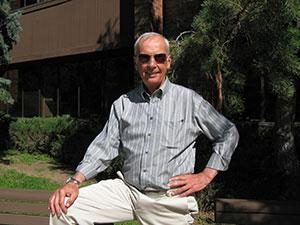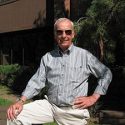
Every year, the R&D 100 Awards—nicknamed the “Oscars of Invention”—showcase the best new technologies from around the world. Most researchers go their entire career without even being nominated. Edwin Tracy (formerly Trzeciak, Class of 1968) just won his second, putting him in elite company and positioning him at the forefront of his field of renewable-energy research.
Considering he almost didn’t finish college, the accomplishment is that much more remarkable.
Ed originally enrolled at Rutgers University, but soon discovered the school “was just too big.” Packed into lecture halls with hundreds of other undergraduates, Ed didn’t get the individualized attention he felt he needed. The final straw came when he failed general physics. He dropped out, and over the next two years took a job as a lab tech and got married.
But his Polish immigrant father—a man with a third-grade education who nonetheless understood the importance of a college degree—begged Ed to finish his schooling. Ed’s wife Cathy (nee Shaluha, Class of 1973) was attending TSC at the time, and told her husband about the small classes and caring faculty here. Liking what he heard, Ed enrolled at the College in the physical sciences program. Four years later, he graduated magna cum laude.
“The difference between having good, dedicated, caring teachers versus that alienation you feel at a larger university where you’re seemingly nothing more than a number—it’s an understatement to say that I’m very satisfied with my experience at the College,” Ed said.
After college, Ed worked at RCA Labs for 12 years before accepting a position with the Department of Energy’s (DOE) National Renewable Energy Laboratory (NREL) in Golden, CO. At NREL, Ed has primarily been involved in research and development in the advanced materials field. He holds 30 U.S. patents, nine foreign patents, and has 11 patents pending, with several of his intellectual properties licensed to industry. Tech transfer of Ed’s inventions has spawned two new business enterprises (Eclipse Energy Systems, Inc. and Planar Energy Devices, Inc.). He has authored or co-authored over 104 technical publications, and has been a long-standing member of the ECS, AVS, and SPIE societies.
At times, the lack of support NREL received from the administration in Washington, DC, made things challenging, Ed said. During his 29 years he has endured two rounds of layoffs and insufficient budgetary support for the scope of the lab’s mission. The eight years under the Bush administration were particularly perplexing in view of the established scientific evidence for global warming, he noted.
“All of us in science were just shaking our heads in disbelief,” he explained. “We began to realize that you have to reach crisis proportions before anything receives appropriate attention in the U.S.”
Things have changed significantly under the Obama administration, though. “It’s finally becoming accepted that the greatest challenge facing our nation will be the search for an alternative to petroleum energy, and NREL is our nation’s premier laboratory for research and development and deployment of renewable energy inventions into the marketplace,” Ed explained.
A prime example of this is the buried anode thin-film battery technology he and two colleagues invented, for which they won the 2009 R&D 100 Award. (It was Ed’s second; his first, received in 1996, was for a vacuum-insulated catalytic converter). Ed’s team developed the buried-anode technology, which a venture capitalist firm licensed to produce the PowerPlane UX Microbattery. Designed for use in remote wireless sensors, smart homes, smart cars, and medical sensing devices, the microbatteries are safe and rechargeable, maintain a long life cycle, and function effectively under high temperatures.
This innovative microbattery based on an inspired digression in the lab is bringing home major awards. But development of this technology holds its greatest promise as a building block for large batteries powering automobiles and storing power generated by wind, solar, and other renewable energy systems. Judging by the acclaim it is receiving, the invention could revolutionize battery technology.
“Hopefully I can live long enough to see it mature and succeed to collect some royalties on it,” Ed joked, before adding seriously, “Honors, awards, and royalty payments are fine, but the humanitarian goals of moving green technologies forward and contributing to NREL’s mission of a better energy future is my real reward.”
He recently transferred to NREL’s Legal Department, where his vast technical perspectives and experience in the renewable energy field with respect to patent preparation and prosecution are utilized. In addition, he continues to direct research on a number of projects, and this self-described “consummate experimentalist” said he still feels most at home in the lab.
He likes to playfully tease his lab colleagues—most of whom hold PhDs from MIT, Harvard, USC, Yale, and Michigan, to name just a few—that whereas their degrees cost them tens of thousands of dollars, his BA from TCNJ cost “a whopping $450 at the time,” he said.
“I am so deeply indebted to the College for providing me with such a well-balanced education, which has resulted in career accomplishments beyond my wildest expectations,” Ed said. “I’ve done all of this with nothing more than a BA from the College. I am convinced that I was educated and trained exceptionally well by some of the best teachers in the world.”
In this regard, he noted, he is highly indebted to Judson Fink, professor emeritus, who “taught me to enjoy as well understand the sophisticated concepts of physics.” “That,” Ed added, “money can’t buy.”
“I believe that if I went to any other college, I would never have accomplished as much as I have,” Ed continued. “I’m not knocking other institutions, but I hope the students at TCNJ realize that they are attending one of the finest small colleges in the country, and if they are diligent in their academic pursuit, the sky’s the limit.”
Finally, Ed lowered his voice and made it a point say, “I sure wish my father were alive to see what his son has accomplished with his hard-earned money spent at TCNJ.”

